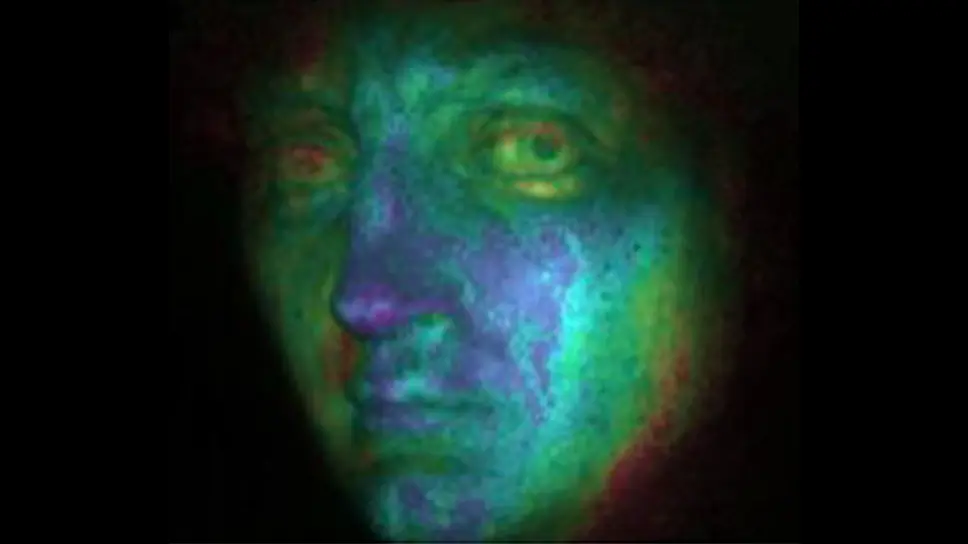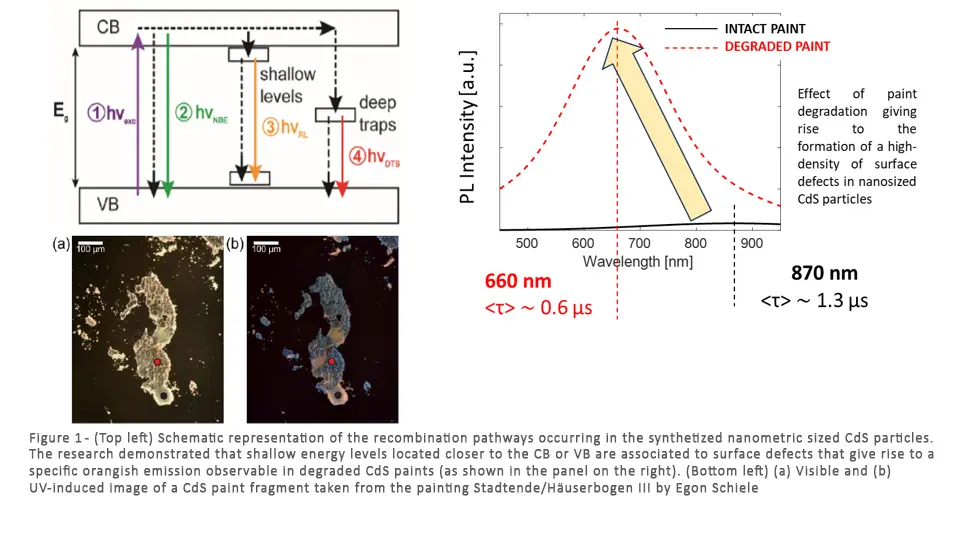ArtIS
ArtIS

ArtIS lab is active in two main research areas:
- Study of the photophysical properties of inorganic materials
- Development of cutting-edge spectroscopy and imaging spectroscopy devices
1. The first research area is focused on the study of crystalline defects in inorganic materials.
Crystalline defects are probed through time-resolved photoluminescence (PL) spectroscopy and microscopy to infer how the density and nature of defects are affected by synthesis methods and how their presence impact the stability/reactivity of the studied materia
Examples of the materials under study encompass (i) semiconductors that have been used as pigments by artists since the 2nd half of the 19th century, (ii) photocatalytic materials based on doped TiO2 and (iii) materials potentially employable as luminescent nanosensors.
Ongoing research includes:
- Study of the PL properties and related crystalline defect of sodalite-based pigments (i.e. ultramarine blue) and basic lead carbonate pigments (i.e. lead white)
- study of synthesis methods of cuprorivaite-based materials to achieve improved crystalline and optical properties for its use as a luminescent nanosensor for biomedical and energy-harvesting applications
- Multiscalar PL analysis of zeolite materials to better understand the physicochemical properties that allow them to function as good catalysts and to optimise them for improved catalytic activity during operando (for example, methanol-to-olefine) experiments.
Examples of past successful research:
Study of the role of crystal defects in cadmium sulfide (CdS) when used as a pigment in artist paints
The research allowed us to infer that synthesizing the pigment using a specific historical method (i.e.: with sodium sulfide as the sodium precursor) yields nanometric sized CdS crystallites with a weakly crystalline structure.
The high surface-to-volume ratio of the synthetized pigment particles results in a high density of defects that promotes CdS surface reactivity and the subsequent deterioration of CdS-based paints. The research further demonstrated that these surface defects are associated with shallow energy levels located closer to the CdS CB or VB, which give rise to a specific orangish PL emission observable in degraded CdS paints (Figure 1).
Study performed in collaboration with:
- the Faculty of Sciences and Technology - NOVA University of Lisbon (research group headed by prof. Maria J. Melo)
- the Science Department of the Getty Conservation Institute (research group headed by dr. Karen Trentelman)
- the Chemistry Department of Politecnico di Milano (research group headed by prof. Lucia Toniolo)
- the European Synchrotron Radiation Facility (ID13 and ID22 beamlines headed by dr. Marine Cotte)
- the Courtauld Institute of Art (research group headed by dr. Austin Nevin).
Main related publications:
- Eur. Phys. J. Plus (2023) 138:906, https://doi.org/10.1140/epjp/s13360-023-04485-1
- Microscopy and Microanalysis (2022), 1–10, https://doi.org/10.1017/S1431927622000873
- Dyes and Pigments 186 (2021) 108998, https://doi.org/10.1016/j.dyepig.2020.108998
- Anal. Chem. 2019, 91, 3421−3428, https://doi.org/10.1021/acs.analchem.8b04914
Study of the links between the optical emission, crystal defects and photocatalytic activity of zinc oxide (ZnO)
The research, aimed to understand the physical processes behind the interaction of ZnO with an oil binding medium, has allowed us to characterize the optical recombination paths associated to specific crystalline defects. We demonstrated that the density of specific point defects (interstitial zinc) is related to the semiconductor tendency to photodegrade the adsorbed organic molecules, such as carboxylic acids, affecting the pigment's role in paint failures (Figure 2).
Study performed in collaboration with:
- Chimie-ParisTech, PSL University (research group headed by Prof. Didier Gourier)
- C2RMF, Palais du Louvre (research group headed by Dr. Thomas Calligaro)
- the Chemistry Department of Università Degli Studi di Milano (research group headed by Prof. Elena Selli),
- the Chemistry Department of Politecnico di Milano (research group headed by prof. Lucia Toniolo)
Main related publications:
- Minerals 2020, 10, 1129; https://doi.org/10.3390/min10121129
- Microchemical Journal 151 (2019) 104256, https://doi.org/10.1016/j.microc.2019.104256
- Microchemical Journal 139 (2018) 467–474, https://doi.org/10.1016/j.microc.2018.03.032
- Materials 2017, 10, 340; https://doi.org/10.3390/ma10040340
- Appl. Phys. A (2016) 122:1053, https://doi.org/10.1007/s00339-016-0578-6
Study of titanium dioxide (TiO2) to assess its stability when used in paints and to study its photocatalytic activity
The research was performed on two main application fields.
- The study of titanium dioxide when used as an artist pigment, where the room-temperature PL emission of the two most stable TiO2 polymorphs (anatase and rutile) has been fully characterized and attributed to different relaxation paths related to shallow levels close to the conduction bands and mid-gap trap states. We further demonstrated that the PL behavior is little affected by post-production treatments, such as organic and inorganic coatings.
- The study of the photoactivity of titanium dioxide co-doped with nitrogen and fluorine and with noble metals nanoparticles photodeposited at TiO2 surface. We demonstrated that, while TiO2 doping with fluorine and nitrogen introduces new stabilized luminescent defective trap states below the conduction band, the presence of noble metal nanoparticles induces a PL intensity suppression, which is ascribed to the formation of new efficient electron transfer paths from luminescent defective trap states, where proton reduction occurs (Figure 3).
Study performed in collaboration with
- the University of Amsterdam (research group headed by Prof. Klaas Jan van den Berg)
- the Chemistry Department of Università Degli Studi di Milano (research group headed by Prof. Elena Selli),
Main related publications:
- Dyes and Pigments 155 (2018) 14–22; https://doi.org/10.1016/j.dyepig.2018.03.012
- J. Phys. Chem. C 2018, 122, 26, 14326–14335, https://doi.org/10.1021/acs.jpcc.8b02997
2. The second research area is aimed at the design and implementation of cutting-edge spectroscopy and imaging methods for materials science and heritage science studies:
- Time-resolved photoluminescence (TRPL) spectroscopy and PL lifetime imaging to study radiative recombination paths of states with lifetimes spanning from sub-nanosecond to tenths of microseconds (Figure 4)
- Hyperspectral imaging (HSI) at variable spatial scales: the HSI camera, based on the patented TWINS interferometer, is coupled to properly designed optical system (Figure 5) to study the photophysical properties of samples with a multiscale and multimodal approach (Figure 6)
- Multimodal microscope for the mapping of PL and Raman signals in heterogeneous and complex materials: Multimodal imaging is a rapidly emerging method that integrates complementary techniques to provide a comprehensive understating of a sample. In our laboratory the combination of PL and Raman spectroscopy mapping, enables us to investigate complex samples with multiple chemical species (Figure 7).
- Photoluminescence spectroscopy at variable excitation fluence: Following excitation, crystalline solids exhibit different radiative and non-radiative recombination pathways that are informative of the energetic structure of the material and of the presence of crystal defects and impurities. To probe these different recombination paths, we use PL spectroscopy at variable excitation fluence to force a non-linear photophysical response of the system. In particular, high fluence induce the saturation of metastable levels and promotes the emission from other radiative and non-radiative pathways (Figure 8). The method is particularly effective for studying the recombination channels in semiconductor materials.







